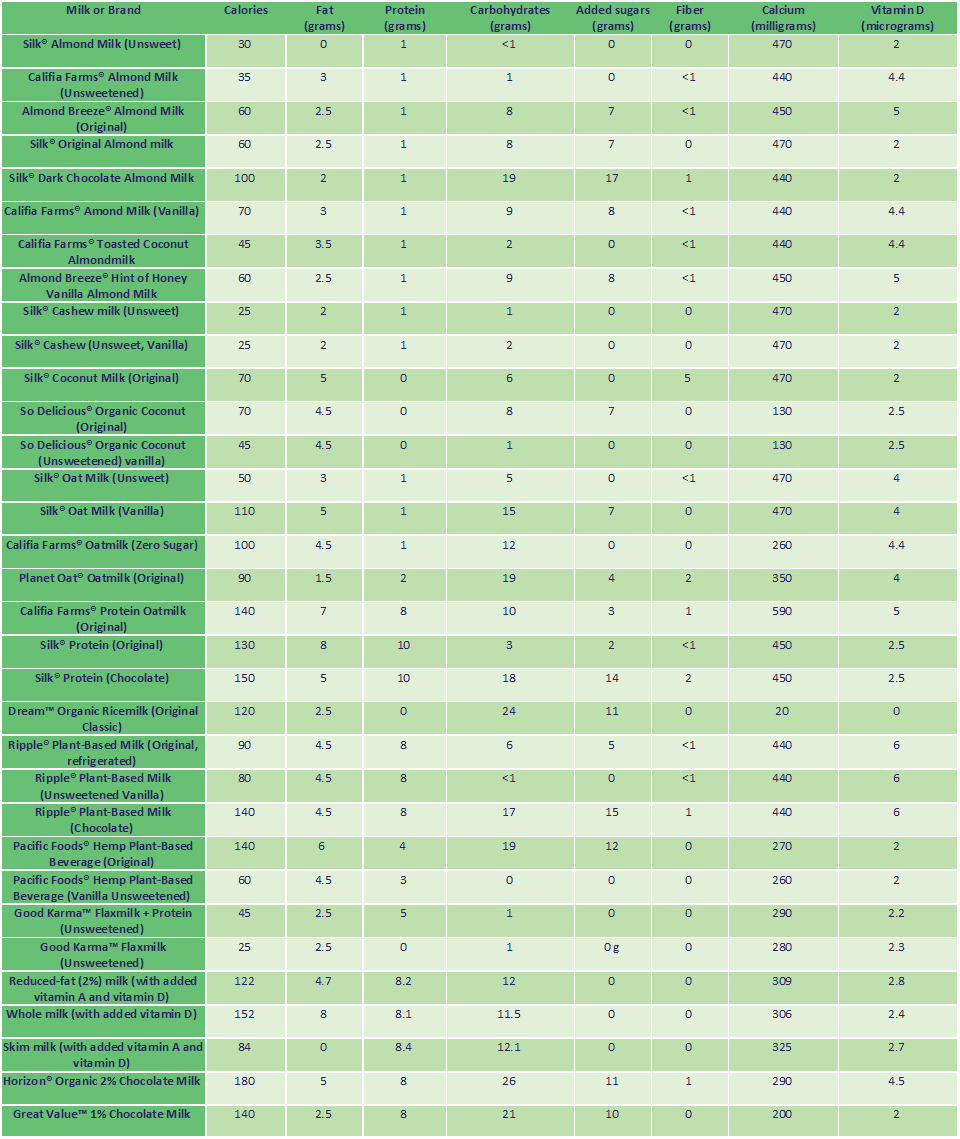Walking through the dairy aisle at the grocery store can feel utterly overwhelming. Shelves are stocked full of attractive, colorful packaging boasting terms such as plant-based, lactose-free, low-fat, DHA omega-3, high vitamin D…the list goes on, and on. Often, looking at the sheer volume of options leaves us with more questions than answers. What does it mean if a milk is “original” or “unsweetened”? Can soybeans and peas really be milked? What does the 2 in “2%” milk refer to? Are plant-based options better than cow’s milk?
Keep reading to find the answers to these questions—and to get a boost of confidence next time you’re at the store.
What are plant-based or alternative milks?
Plant-based milks are beverages made by blending or grinding a plant ingredient with water and filtering out the plant solids. The resulting liquid, usually an off-white color, resembles traditional cow’s milk.
Available milk options include:
- Nut-based milks such as cashew, almond, and coconut milks
- Seed-based milks such as hemp and flaxseed milks
- Grain-based milks such as rice and oat milks
- Legume-based milks such as pea protein and soy milks
Why choose a plant-based milk?
Food allergies and intolerances
Plant-based milks can be healthy options for individuals who are allergic to the protein found in cow’s milk or who experience lactose intolerance. Another option for people with lactose intolerance is lactose-free cow’s milk—milk in which lactose is filtered or broken-down.
Environmental impact
Overall, the production of plant-based milks is associated with a smaller carbon footprint compared to the production of dairy milk. Producing plant-based milks also requires less water. But it’s worth noting that certain farming practices are harmful to the environment and industry workers. For example, most coconuts come from regions known for low wages and exploitive labor practices. Soy farming is associated with deforestation of the Amazon rainforest. And almond farming in the US has been linked to significant deaths in the commercial bee population.
Health
Many plant-based milks are lower in calories and saturated fat than cow’s milk, which can be beneficial for those trying to manage their weight or cholesterol levels. Cow’s milk has lactose (a carbohydrate) and may not be suitable for individuals who need to follow a very low-carbohydrate diet. Certain plant-based milks are low in protein, which can be beneficial for people with certain types of kidney disease or others who need to eat less protein.
Are plant-based milks nutritious?
The short answer: it depends. A 2023 study that analyzed the nutritional profile of more than 200 plant-based milks found that only 12 percent had at least as much protein, calcium, and vitamin D as cow’s milk.
In general, almond, coconut, rice, and oat milk are low in protein. Soy, pea protein, and nut-blend milks are generally higher in protein. Currently, fortified soy milk is the only plant-based alternative that’s included in the dairy group in the federal government’s Dietary Guidelines for Americans. Individuals who eat a varied diet can likely get enough protein from other food sources. But for those who have high protein needs—for instance, toddlers, athletes, or cancer patients—low-protein plant-based options may not be appropriate. Protein also helps us feel full and can curb hunger, which is helpful for those who are trying to manage their weight.
Some plant-based milks (chiefly, coconut milk and coconut milk blends) can be as high or higher in saturated fat than cow’s milk. Intake of saturated fats is associated with an increase in LDL cholesterol (the so-called “bad cholesterol”) and higher risk of heart disease.
The calcium and vitamin D content of plant-based milks can vary widely. These nutrients are important for supporting strong bones, but they can be difficult to get from food. Data from the 2007-2010 and the 2015-2016 National Health and Nutrition Examination Survey (NHANES) revealed that a sizable portion of the US population gets less than the recommended amount of calcium and vitamin D.
A one cup serving of non-fat cow’s milk supplies approximately 25% of the calcium and 13% of the vitamin D needs of the average adult. Reassuringly, the 2023 study found that 72% of the plant-based milks reviewed were fortified with calcium and vitamin D at levels on par with cow’s milk. It’s important to give plant-based milks a good shake before serving, as calcium and vitamin D may not dissolve as easily in plant-based milks as they do in cow’s milk.
Scroll below to compare the nutritional content of some common cow’s milk and plant-based milk options.
Why are some plant-based milks flavored or sweetened?
Cow’s milk has lactose, a natural sugar. Lactose tastes 20-40% as sweet as regular table sugar (sucrose) and gives cow’s milk a mildly sweet taste. Most plant-based milks are naturally low in sugar. In an effort to enhance the taste of these milk alternatives, manufacturers may add sucrose or flavors (usually chocolate or vanilla). But sugars are not all equal. Lactose is digested more slowly than sucrose. Cow’s milk, therefore, tends to have a lower impact on a person’s blood sugar. A plant-based milk with added sugars is more likely to increase a person’s blood sugar. Grain-based plant milks (ex: oat milk and rice milk) are naturally high in carbohydrates. These carbohydrates can be easily digested and are more likely to raise a person’s blood sugar.
Why are some cow’s milk and yogurts labeled as 2%, 1% or 0%?
Whole-fat cow’s milk has a 3.25% fat content by weight. That means that for every 100 grams of whole-fat cow’s milk, there are 3.25 grams of fat. Reduced-fat milk has a 2% fat content by weight and low-fat milk has a 1% fat content by weight. Skim milk has less than a 0.5% of fat content by weight and may be labeled as 0%. It’s important to remember that the percentage refers to the fat content by weight, not the percent of fat left after the milk is defatted. Compared to whole-fat cow’s milk, reduced-fat (2%) milk has 38% less fat and low-fat (1%) milk has 69% less fat.
Interested in exploring other nutrition topics or discussing healthy eating to fit your lifestyle? Avance Care dietitians are available to help. You can book online by visiting avancenutrition.com or by calling (919) 237-1337, option 4.
Nutrition Facts of Popular Cow’s Milk and Plant-Based Milk Brands
Information listed below is per 240 mL (8 oz) serving.


